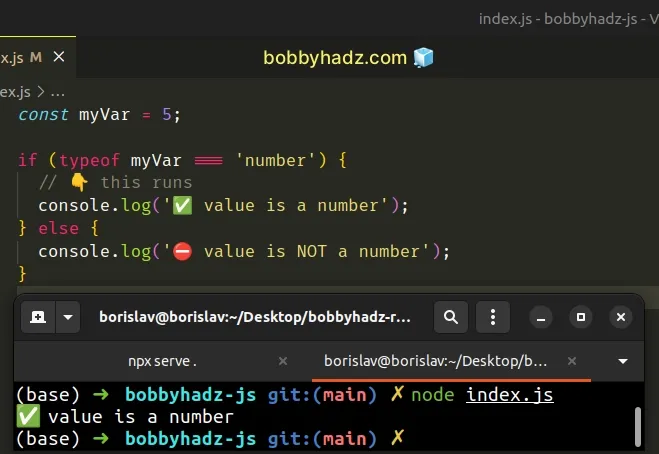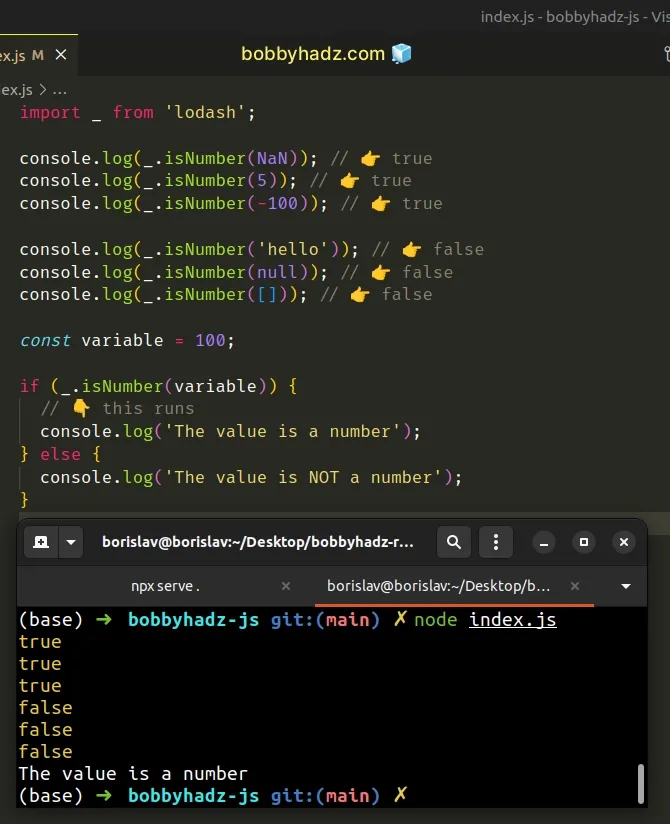How to Check if a Value is a Number in JavaScript
Last updated: Mar 4, 2024
Reading time·5 min

# Check if a Value is a Number in JavaScript
You can check if a value is a number in three ways:
typeof- if the value is a number, the string"number"is returned.Number.isFinite()- if the value is a number,trueis returned.isNaN()- if the value is a number,falseis returned.
# Check if a Value is a Number using the typeof operator
Use the typeof operator to check if a value is a number in JavaScript.
The typeof operator will return the string "number" if the value is of type
number.
const myVar = 5; if (typeof myVar === 'number') { // 👇️ this runs console.log('✅ value is a number'); } else { console.log('⛔️ value is NOT a number'); }

We used the typeof operator to check if a value is a number.
The typeof operator returns a string that indicates the type of a value. Here
are some examples.
console.log(typeof 5); // 👉️ "number" console.log(typeof '5'); // 👉️ "string" console.log(typeof NaN); // 👉️ "number" console.log(typeof {}); // 👉️ "object" console.log(typeof []); // 👉️ "object" console.log(typeof null); // 👉️ "object"
If you look closely, you'll notice that
NaN (Not a Number)
is also of type number.
Use the Number.isNaN() method to make sure NaN values don't meet the
condition.
const myVar = 5; if (typeof myVar === 'number' && !Number.isNaN(myVar)) { // 👇️ this runs console.log('✅ value is a number'); } else { console.log('⛔️ value is NOT a number'); }
We used the logical AND (&&) operator to chain a second condition.
Both conditions have to be met for our if block to run.
Notice that we used the logical NOT (!) operator to negate the call to
Number.isNaN method.
The NOT (!) operator takes the return value of the method, converts it to a boolean and then flips it.
The
Number.isNaN
method checks if the passed-in value is NaN (not a number) AND its type is
number.
Here are some examples:
console.log(Number.isNaN(NaN)); // 👉️ true console.log(Number.isNaN(Number.NaN)); // 👉️ true console.log(Number.isNaN(0 / 0)); // 👉️ true console.log(Number.isNaN(5)); // 👉️ false console.log(Number.isNaN('5')); // 👉️ false console.log(Number.isNaN({})); // 👉️ false
Only NaN, Number.NaN and 0 / 0 return true.
number and it's not NaN, then it is a valid number.# Check if a Value is a Number using Number.isFinite()
Alternatively, you can use the Number.isFinite().
The method returns true if the provided value is of type number and is not
positive or negative Infinity or NaN.
const myVar = 5; if (Number.isFinite(myVar)) { // 👇️ this runs console.log('✅ value is a number'); } else { console.log('⛔️ value is NOT a number'); }

We used the Number.isFinite() method to combine the conditions from the previous example.
The Number.isFinite() method checks that the provided value:
- is of type
number - is not positive or negative
Infinity - is not
NaN
Here are some examples:
console.log(Number.isFinite(5)); // 👉️ true console.log(Number.isFinite(5.5)); // 👉️ true console.log(Number.isFinite('5')); // 👉️ false console.log(Number.isFinite(NaN)); // 👉️ false console.log(Number.isFinite(null)); // 👉️ false
Number.isFinite method is not as commonly used as the typeof operator. If you use it in your code, you might surprise quite a lot of developers.# Check if a Value is a Number using NaN
There are 2 isNaN methods in JavaScript:
Number.isNaN()- checks if the passed-in value is of typenumberand isNaN(no coercion)isNaN()- coerces the value to a number and checks if the value isNaN
// ⛔️ Don't do this const myVar = 5; if (!isNaN(myVar)) { // 👇️ this runs console.log('value might be a number'); } else { console.log('value is NOT a number'); }
We negated a call to the isNaN() function to check if the passed-in value can be coerced to a number.
Here are some examples of using isNaN.
console.log(isNaN(5)); // 👉️ false console.log(isNaN('5')); // 👉️ false console.log(isNaN(3.5)); // 👉️ false console.log(isNaN('3.5')); // 👉️ false console.log(isNaN('3.5abc')); // 👉️ true console.log(isNaN({})); // 👉️ true console.log(isNaN([])); // 👉️ false console.log(isNaN(true)); // 👉️ false console.log(isNaN(false)); // 👉️ false console.log(isNaN(null)); // 👉️ false console.log(isNaN(undefined)); // 👉️ true
number, the isNaN function converts the value to a number before checking if it's NaN.This goes wrong in many cases because many non-numeric values convert to valid numbers. Here are some examples:
console.log(Number(null)); // 👉️ 0 console.log(Number([])); // 👉️ 0 console.log(Number('')); // 👉️ 0 console.log(Number(true)); // 👉️ 1 console.log(Number(false)); // 👉️ 0
For any of these values, you would get a false positive.
You should never use this approach, as it leads to confusing behavior and difficult to track bugs.
# Check if a Variable is a Number using lodash
First, make sure you have lodash installed by running the following command
from your terminal.
# 👇️ initialize package.json if you don't have one npm init -y npm install lodash
Now you can import and use the isNumber method to check if a value is a number.
import _ from 'lodash'; console.log(_.isNumber(NaN)); // 👉️ true console.log(_.isNumber(5)); // 👉️ true console.log(_.isNumber(-100)); // 👉️ true console.log(_.isNumber('hello')); // 👉️ false console.log(_.isNumber(null)); // 👉️ false console.log(_.isNumber([])); // 👉️ false const variable = 100; if (_.isNumber(variable)) { // 👇️ this runs console.log('The value is a number'); } else { console.log('The value is NOT a number'); }

The lodash.isNumber() method returns true if the supplied value is a number
and false otherwise.
Even if you already use lodash in your project, I would advise against using
the isNumber() method as the typeof operator is sufficient and doesn't
require you to use an external library.
# Don't use the instanceof operator to check if a value is a number
You should never use the instanceof operator to check if a value is of type
number.
import _ from 'lodash'; function isNumber(value) { return value instanceof Number; } console.log(isNumber(100)); // 👉️ false console.log(isNumber(-1000)); // 👉️ false console.log(isNumber(new Number(10))); // 👉️ true console.log(isNumber(new Number(-100))); // 👉️ true console.log(isNumber(null)); // 👉️ false console.log(isNumber('')); // 👉️ false
The syntax for the
instanceof operator
is object instanceof constructor.
The operator returns true if the prototype property of the constructor
appears anywhere in the prototype chain of the object.
Notice that the operator returns true only for object-wrapped numbers.
These are numbers that were created with the new Number() constructor.
You should never use the new Number() constructor in your code, so you should
never have to use the instanceof operator to check if a value is a number.
The typeof operator is all you need in order to check if a value stores a
number in JavaScript.
const myVar = 5; if (typeof myVar === 'number') { // 👇️ this runs console.log('✅ value is a number'); } else { console.log('⛔️ value is NOT a number'); }
# Additional Resources
You can learn more about the related topics by checking out the following tutorials:

